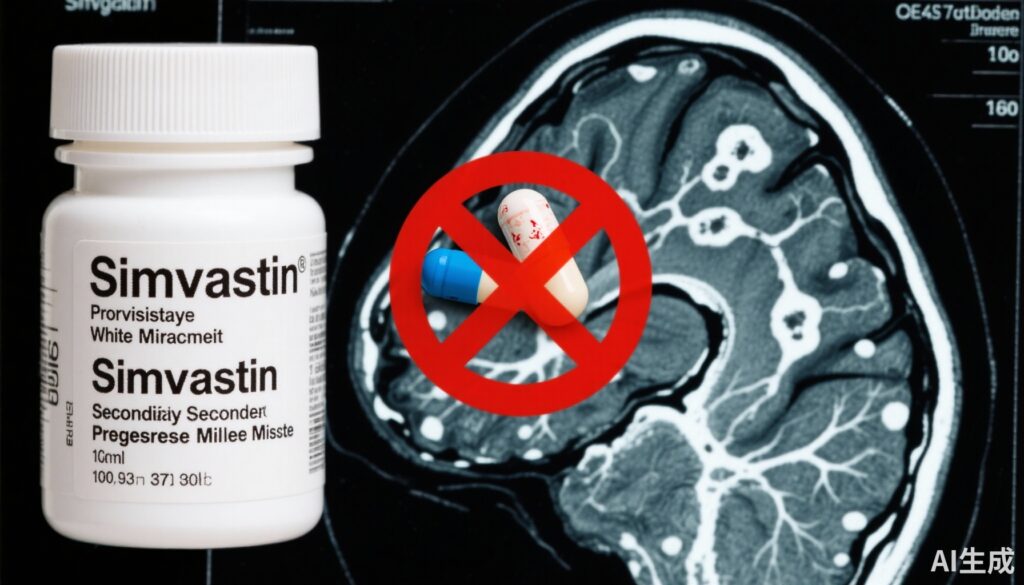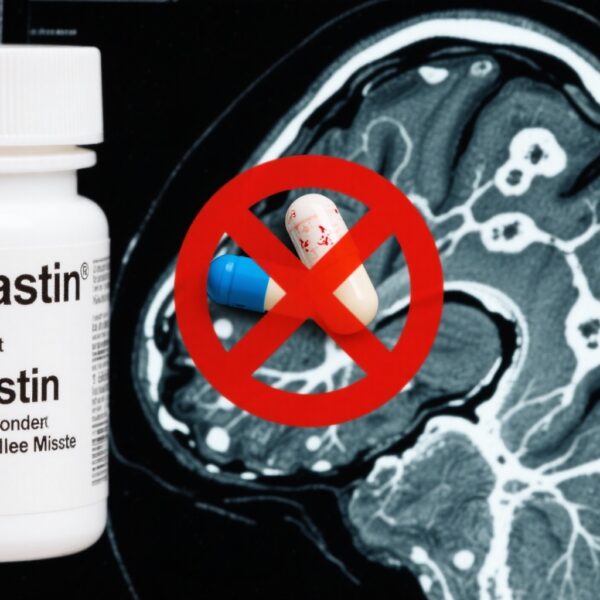Highlight
- The MS-STAT2 trial, a phase 3 randomized controlled study, found that simvastatin 80 mg daily did not significantly slow disability progression in secondary progressive multiple sclerosis (SPMS).
- Despite prior phase 2 evidence suggesting a neuroprotective effect via reduced brain atrophy, this large, long-term trial showed no clinical benefit on confirmed disability worsening over up to 4.5 years.
- The safety profile was generally acceptable with no emergent safety issues, although one serious adverse reaction of rhabdomyolysis occurred in the simvastatin group.
- Simvastatin use in multiple sclerosis should remain limited to existing vascular indications rather than as a disease-modifying therapy.
Study Background
Secondary progressive multiple sclerosis (SPMS) represents a critical phase in the trajectory of multiple sclerosis (MS), characterized by progressive neurological disability largely independent of acute inflammatory relapses. Unlike relapsing-remitting MS, where immunomodulatory therapies have demonstrated robust benefits, interventions to slow or halt progression in SPMS remain elusive. Neurodegeneration in SPMS is believed to be driven by multifactorial mechanisms including chronic inflammation, mitochondrial dysfunction, vascular comorbidities, and the impact of aging on neural tissue.
Statins, widely used cholesterol-lowering drugs, have demonstrated pleiotropic effects such as immunomodulation, anti-inflammatory properties, and potential neuroprotection. Earlier phase 2 evidence, particularly the MS-STAT trial, indicated that high-dose simvastatin (80 mg daily) reduced the rate of brain atrophy by 43% compared to placebo over two years. Such radiological findings suggested that simvastatin may slow neurodegeneration in SPMS, prompting the current phase 3 MS-STAT2 trial to evaluate definitive clinical outcomes.
Study Design
MS-STAT2 was a multicenter, randomized, double-blind, placebo-controlled phase 3 clinical trial conducted across 31 UK neuroscience centers and district general hospitals. Eligible participants were adults aged 18 to 65 years with clinically diagnosed SPMS and baseline Expanded Disability Status Scale (EDSS) scores between 4.0 and 6.5, reflecting moderate disability with ambulatory impairment but not wheelchair dependence.
Participants (n=964) were randomly assigned in a 1:1 ratio to receive oral simvastatin 80 mg daily or matched placebo for up to 4.5 years. Randomization utilized a minimization algorithm within a secure online system to balance baseline characteristics. Both participants and clinical teams were masked to treatment assignments. The primary endpoint was time to 6-month confirmed disability progression measured by EDSS worsening—a ≥1 point increase if baseline EDSS was <6.0 or ≥0.5 point increase if baseline EDSS ≥6.0—analyzed on an intention-to-treat basis without imputation.
Key Findings
Among 964 participants, 73% were female with a mean age of 54 years. The primary endpoint of 6-month confirmed disability progression occurred in 36% of placebo-treated participants and 40% of simvastatin-treated participants. The adjusted hazard ratio for disability progression in the simvastatin group was 1.13 (95% confidence interval [CI] 0.91 to 1.39, p=0.26), indicating no statistically significant reduction in progression risk.
Secondary analyses also failed to demonstrate beneficial effects on other clinical or radiological markers. Safety outcomes revealed a generally acceptable profile for simvastatin; however, one serious adverse reaction of rhabdomyolysis was reported in the treatment group. Cardiovascular serious adverse events were numerically fewer in the simvastatin group (1%) versus placebo (2%).
This trial decisively contradicted prior phase 2 findings that highlighted simvastatin’s neuroprotective potential based on imaging endpoints. The lack of translation from improved brain atrophy rates to meaningful disability delay may reflect several factors including the complex multifaceted pathobiology of SPMS, phenotypic heterogeneity, the limitation of EDSS as a measure, and perhaps insufficient neurorestorative capacity of statin therapy at this disease stage.
Expert Commentary
The MS-STAT2 trial provides robust, high-level evidence that simvastatin in high dose does not alter disability progression in SPMS despite promising neuroimaging data from the earlier MS-STAT study. This discrepancy highlights the challenges in translating surrogate imaging biomarkers to clinically relevant outcomes in progressive MS. The trial also emphasizes the necessity of large, adequately powered phase 3 studies with clinical endpoints to validate repurposed therapies.
It remains possible that subsets of SPMS patients with specific vascular comorbidities or earlier disease stages might derive some benefit, but such hypotheses require further stratified research. Additionally, statins’ hypothesized mechanisms involving vascular risk reduction do not appear sufficient alone to impact neurodegeneration-driven disability accumulation in established SPMS.
From a methodological perspective, the trial’s strengths include its rigorous randomization and blinding, long follow-up, and clinically meaningful endpoints. Limitations include reliance on EDSS, which has recognized limitations in sensitivity to change and functional domains such as cognition. Future trials might incorporate composite or digital disability measures and explore multidimensional therapeutic approaches.
Conclusion
The MS-STAT2 trial conclusively shows that simvastatin 80 mg daily does not slow disability progression in secondary progressive multiple sclerosis. While this negates simvastatin’s role as a disease-modifying agent in SPMS, it underscores the complex and multifactorial nature of neurodegeneration in this disease stage. Clinicians should reserve simvastatin use in MS patients for established vascular indications rather than as a neuroprotective strategy. Ongoing efforts to identify effective therapies for progressive MS must continue to innovate beyond repurposed agents to address underlying neurodegenerative mechanisms comprehensively.
References
1. Chataway J, Williams T, Blackstone J, et al. Effect of repurposed simvastatin on disability progression in secondary progressive multiple sclerosis (MS-STAT2): a phase 3, randomised, double-blind, placebo-controlled trial. Lancet. 2025 Oct 1:S0140-6736(25)01039-6. doi: 10.1016/S0140-6736(25)01039-6. Epub ahead of print. PMID: 41045938.
2. Chataway J, et al. Simvastatin for secondary progressive multiple sclerosis: a randomised, placebo-controlled, phase 2 trial. Lancet. 2014;383(9936):2213-21.
3. Lublin FD, Reingold SC. Defining the clinical course of multiple sclerosis: results of an international survey. Neurology. 1996 Apr;46(4):907-11.



